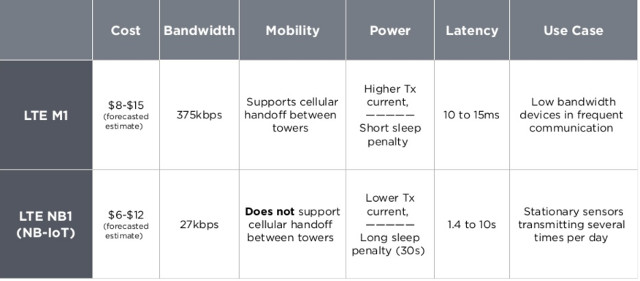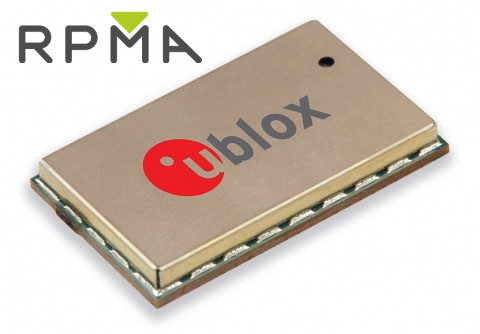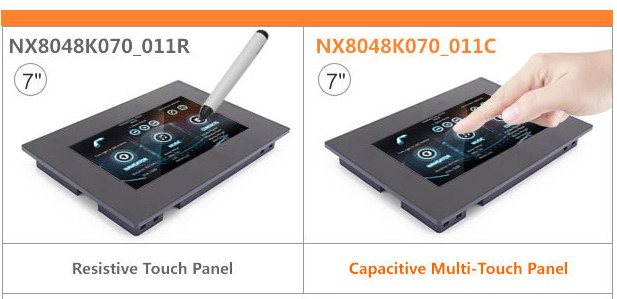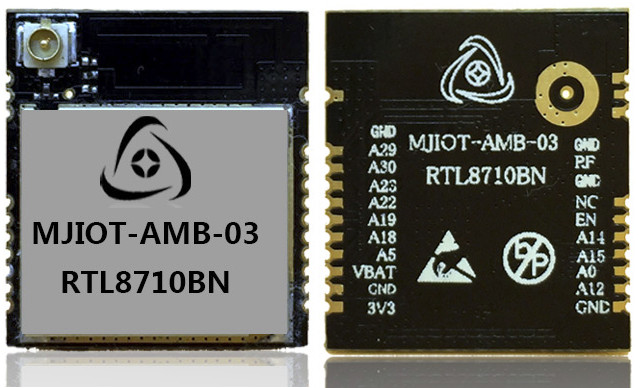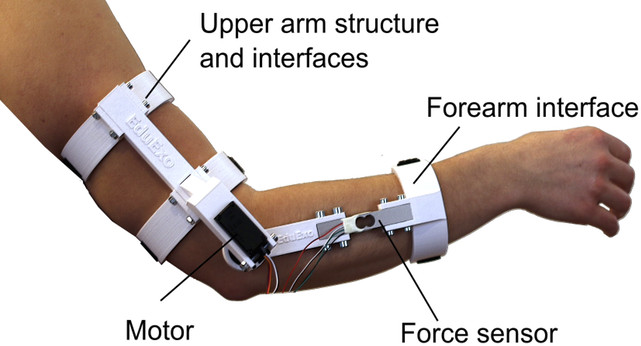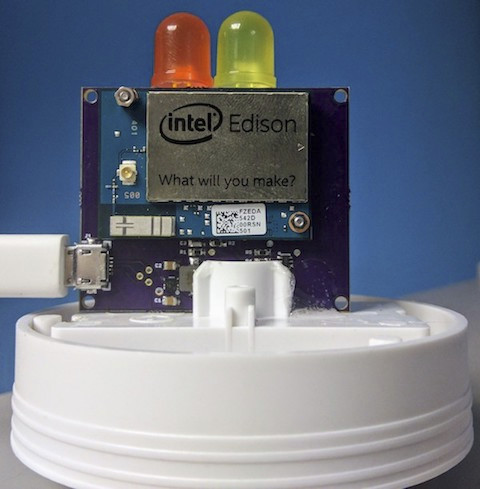Telecom companies also want their share of the IoT business, but with 2G to 4G cellular technology often being too power hungry and/or expensive for this market, 2G on-going – or upcoming – sunset depending on your location, LTE Cat M1 and LTE Cat NB1 (aka NB-IoT) standards have been developed, and used in products like Pycom FiPy board, and SARA-R4 and SARA-M2 modules. If you want to have an overview learn about the new LTE IoT standards and the future of cellular IoT, Particle has published a useful presentation – embedded below – dealing with both, as well as eSIM (Embedded SIM), 2G sunset, and battery life expectations. The main takeaways from my reading of the presentation: LTE NB1 is better suited for low power stationary sensors transmitting a small amount of data a few times a day. Requires new hardware and software LTE M1 can be used for […]
u-blox SARA-S200 RPMA Module Supports the Machine Network
RPMA is one of the many LPWAN IoT communication standards, but it does not get as much press coverage as SigFox or LoRa because it targets larger scale deployments, and is not really accessible to individuals. It’s still used by companies in many countries, and u-blox has just released SARA-S200 RPMA module that will also work with the Machine Network, also relying on RPMA and managed by Ingenu. u-blox SARA-S200 module specifications: Connectivity Wireless Frequency – 2.4 GHz ISM Radio Spectrum – 80 MHz Occupied Bandwidth – 1 MHz Modulation – Dynamic – Direct Sequence Spread Spectrum (D-DSSS) Multiple Access Scheme – Random Phase Multiple Access (RPMA) Transmit Power – +22 dBm Receive Sensitivity – -133 dBm Data Throughput – 100 kB per day Link budget – 176 dB (FCC/IC) Host Interface – 7-wire SPI that includes handshaking for deep sleep modes Power Supply – 3.2 V to 3.4 V […]
HTC U11 Android Smartphone Adds “Edge Sense” Squeeze Input, Ranks Best at DxOMark Mobile Camera Benchmark
We’ve come so far in the smartphone market that most hardware releases are rather boring with a processor a little faster, maybe a higher resolution screen and so on, without real exciting innovations. HTC U11 does change that somewhat as the smartphone allows to interaction by squeezing the edges for example to quickly take a picture. The company calls that “Edge Sense” technology. HTC U11 specifications: SoC – Qualcomm Snapdragon 835 octa-core processor @ up to 2.45 GHz System Memory – 4GB / 6GB RAM Storage – 64GB / 128GB flash, micro SD slot up to 2TB (shared with SIM2 slot), flex storage (aka adoptable) supported Display – 5.5″ Quad HD (2560 x 1440 pixels) Super LCD; 3D Corning Gorilla Glass 5 Cellular Connectivity Dual nano SIM 2G/2.5G – GSM/GPRS/EDGE @ 850/900/1800/1900 MHz 3G – UMTS @ 800/900/1900/2100 (B5/B8/B2/B1), HSDPA 42, HSUPA 5.76 4G LTE – Cat 15 LTE up […]
Rockchip Android TV Boxes Promotion Starting at $13.99 (US Only)
GearBest is organizing a promotion for its US warehouse, and there are three good deals for TV boxes, especially with Rockchip RK3229 based SCISHION V88 going for $13.99 (limited to 30 units). Make sure you only buy one, as usually, the company will cancel orders with more than one piece for this type of promotion. If the 1GB RAM in V88 is too little for you, you may consider V88 Plus model with 2GB selling for $17.99, or Dolamee D5. There’s also a $10 discount$10 discount on Yundoo Y8 RK3399 TV Box. They also have some other discounts for 3D Printers, and drones/rc toys. All you need is a physical address in the US. Jean-Luc Aufranc (CNXSoft)Jean-Luc started CNX Software in 2010 as a part-time endeavor, before quitting his job as a software engineering manager, and starting to write daily news, and reviews full time later in 2011. www.cnx-software.com
Nextion Enhanced NX8048K070 is a 7″ Resistive or Capacitive Programmable Touch Display with an Optional Enclosure
Nextion displays are designed to be controlled by MCU boards with the user interface designed in Nextion Editor drag-and-drop tool. ITEAD Studio launched them in 2015, and I played with Nextion 2.4″ and 5.0″ models, but at the time, I found the Windows only Nextion Editor program not to be that user-friendly and inconvenient to use, as for example, UI designs do not automatically scale across all display sizes. The company is now back with a 7″ model, available with resistive or capacitive touch panel, and featuring an ARM7 processor exposing 8 GPIOs. Nextion Enhanced NX8048K070 (_011) specifications: CPU – ARM7 processor @ 108 MHz with 8K RAM, 1024 EEPROM, 1024 bytes instruction buffer Storage – 32MB flash memory, micro SD card slot Display – 7″ TFT display with resistive or capacitive panel; resolution: 800×480; 65K colors; adjustable brightness: 0 to 230 nit Expansion – 8x GPIOs including 4x PWM, […]
Realtek RTL8710BN ARM Cortex M4 WiFi MCU, MJIOT-AMB-03 Module & Board, and Ameba 4.0a SDK
We’ve already covered Realtek Ameba ARM Cortex M3 WiSoC several times with their RTL8710AF, RTL8711AM and RT8195AM solutions, but the company has now a new “Ameba Z series” relying on an ARM Cortex M4 core starting with RTL8711BN MCU. RTL8710BN specifications as listed on Realtek website: CPU – ARM Cortex-M4(F) up to 125MHz with FPU (TBC) Memory – 256KB embedded SRAM Storage – 512KB embedded ROM, external flash interface; XIP (eXecut In Place) support Wi-Fi 2.4GHz 1T1R 802.11b/g/n up to 150Mbps; 20MHz and 40MHz WEP, WPA, WPA2, WPS support Security engine – MD5, SHA-1, SHA2-256, DES, 3DES, AES Peripheral Interfaces SDIO Slave 2x UART SPI interface (Master/Slave) 2x I2C interface ADC for voltage management 5x PWM Up to 17x GPIOs Package – QFN-32; 5 x 5 mm AFAIK, other Ameba MCUs do not support XIP, but RTL8710BN and this lowers memory requirements since code can be executed from storage. MJIOT-AMB-03 module […]
EduExo DIY Robotic Exoskeleton Kit is Arduino Powered, 3D Printable, Designed for STEM Education (Crowdfunding)
Robotic exoskeletons are used for medical purposes such as helping with the rehabilitation of stroke patients, or enable paraplegics to walk again, as well as in the work place to assist people lifting heavy objects. While it’s possible to learn about the theory about exoskeleton technology, practical experience may help grasping all concepts better. However, there are not many courses available, and exoskeletons are usually expensive, so Volker Bartenbach, PhD at ETH in Zürich, has decided to created EduExo robotic exoskeleton kit for education purpose. The EduExo hardware is based on off-the-shelf components like an Arduino UNO board, a motor, and a force sensor, as well as a rigid exoskeleton structure and cuff interfaces. The latter is optional as you can get the kit without it, and will instead receive the STL files to 3D print the parts yourself. There’s also a handbook to help you get started in several […]
Visualizing Electronics Manufacturing Price Variation with Volume and Lead Time
Google Android Things developers announced a production hardware sample based on Intel Edison module: Android Things is focused on helping developers build production ready devices that they can bring to market. This means building custom hardware in addition to the app software running on the Android Things system-on-module (SoM). As a part of this effort we have released Edison Candle, the first in a series of production samples designed to showcase hardware and software designed to work together. The code is hosted on GitHub and the hardware design files are on CircuitHub. That’s what the Edison Candle looks like. It’s just demo hardware to show how to build a product with a system-on-module (Intel Edison) for Android Things with everything released in Github. You can also purchase the board on CircuitHub, but then I saw the price was around $356 for such a simple board (without Edison). That’s quite a […]


